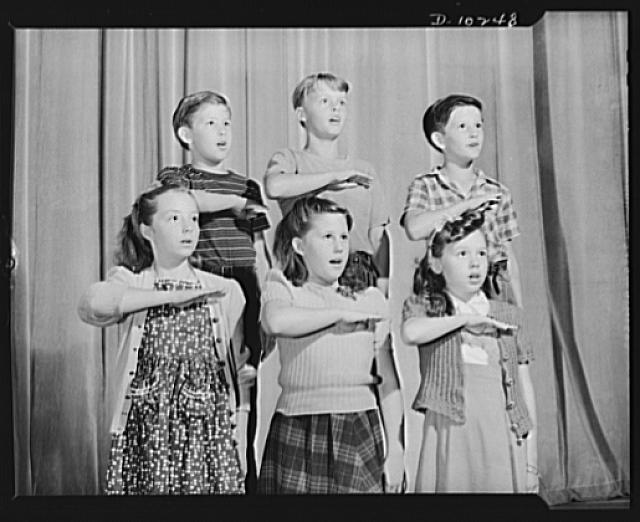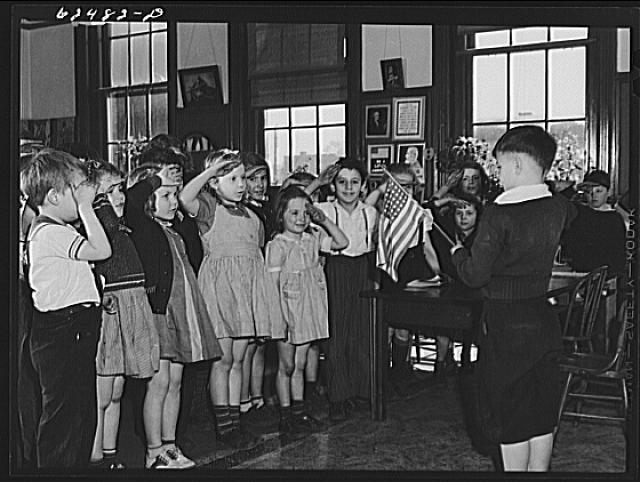Pledge of Allegiance (original) (raw)
Written by
, published on August 10, 2023 last updated on July 9, 2024

America’s most common form of paying respect to a national emblem or symbol, the flag salute with the Pledge of Allegiance, started as part of a nationwide public school observance in 1892 honoring the 400th anniversary of Columbus’s discovery of America. By 1935, 24 states had statutes requiring instruction in flag respect; nine specifically required that the flag salute ceremony be conducted regularly in all public schools. The Supreme Court has ruled that compelling schoolchildren to recite the Pledge of Allegiance violates the First Amendment. The court has not struck "under God" from the pledge. (Schoolchildren pledge allegiance to the flag, circa 1899, via Library of Congress, public domain)
America’s most common form of paying respect to a national emblem or symbol, the flag salute with the Pledge of Allegiance, started as part of a nationwide public-school observance in 1892 honoring the 400th anniversary of Columbus’s discovery of America.
James B. Upham and Francis Bellamy, both of whom worked for The Youth’s Companion magazine, coordinated the event, which was designed in part to help assimilate immigrants.
The wording of the pledge has changed
George Thacher Balch, a retired military officer then serving as the auditor for the New York City Board of Education, penned the original pledge, which said, “We give our Head!—and our Hearts! –to God! And our Country! One Country! One Language! One Flag!”
Francis Bellamy, a former Baptist preacher who favored socialism, subsequently revised the pledge with words more familiar today: “I pledge allegiance to my flag, and to the republic for which it stands, one nation with liberty and justice for all.” The phrase “my flag” was changed to “the flag” in 1923, and the words “of America” were added the next year.
The pledge soon became popular and was widely used in schools in every state. By 1935, 24 states had statutes requiring instruction in flag respect; nine specifically required that the flag salute ceremony be conducted regularly in all public schools. None explicitly demanded pupils participate in the ceremony as it was, at the time, almost inconceivable that anyone might refuse.
Jehovah’s Witnesses refused flag salute and pledge
As early as 1918, the Mennonites, among others, refused the salute and pledge because they thought it implied a promise to bear arms, and for the most part, school officials chose to grant exemptions. This indulgence continued until the Jehovah’s Witnesses, who were also conscientious objectors and who believed the flag had become an object of idolatry, objected in the 1930s and 1940s.
The Witnesses were decidedly unpopular in the 1930s and 1940s because of their methods of aggressive proselytizing and their repeated and severe condemnations of other religions. Their status as conscientious objectors also contributed to their unpopularity during World War II. In the mid-1930s, a Witnesses leader endorsed nonsaluting and sparked a wave of refusals just as the flag salute became an issue again with war raging in Europe. School officials reacted with disciplinary action. Pennsylvania and Massachusetts alone expelled more than 200 Jehovah’s Witness children from school. In most instances these children still faced compulsory education laws, meaning they had to enroll in private schools or be liable to prosecution.
In 1940, Supreme Court said schoolchildren had to recite pledge
The Witnesses brought suits in six states to compel readmission of their children and lost each time. On four occasions in the 1930s, the Supreme Court refused petitions for certiorari from these rulings. Finally, in April 1940, the Supreme Court heard a Jehovah’s Witness readmission case.
Walter Gobitas (his name was misspelled Gobitis, which became the official spelling in the Supreme Court case) had brought suit before a federal district judge in Philadelphia for an injunction compelling the readmission of his two expelled children to the Minersville, Pennsylvania, public schools. The district court held that the compulsory flag salute violated the religious freedom clause when enforced against the Jehovah’s Witnesses, and the circuit court of appeals affirmed this decision. The school board appealed to the Supreme Court which, to the surprise of many, reversed the lower courts.

The Supreme Court in 1943 held that government could not compel citizens to express beliefs through salute to the American flag without violating freedom of speech, regardless of whether the objections to saluting the flag were religiously based or not (Fifth-graders in a public school in Hollywood, pledge allegiance to the flag during the War Production Board’s presentation on May 27, 1942, via Library of Congress, public domain)
The Supreme Court, in Minersville School District v. Gobitis (1940) — with Justice Felix Frankfurter writing for an 8-1 court with Justice Harlan Fiske Stone dissenting — held that a child could constitutionally be expelled from public school for refusing to participate in the daily flag salute ceremony even though participation violates the child’s religious beliefs. Stone’s dissent stressed that the majority was upholding a law that coerced children to express a sentiment in violation of their deepest religious convictions.
Jehovah’s Witness children expelled from schools
Within two years Gobitis was under fire from all sides. The decision had ushered in a period of violence perpetrated against Jehovah’s Witnesses. In one week the Department of Justice received reports of hundreds of physical assaults on Jehovah’s Witnesses by citizens and public officials. Also as a result of the ruling, school districts in 31 states made the pledge compulsory and expelled over two thousand Witness children who refused to comply. Further complicating the situation was congressional passage of a joint resolution codifying the rules of flag etiquette. As the violence grew, so did unfavorable reaction to Gobitis.
In 1943, Supreme Court says compelling flag salute in public schools violates freedom of speech
Walter Barnette’s children, and others, had been expelled from school for insubordination. Barnette could not afford private schooling and faced potential fines or imprisonment for failing to adhere to compulsory education laws. The Jehovah’s Witnesses filed a class-action lawsuit in Charleston, West Virginia, in August 1942, and the case was heard by a three-judge panel, which decided unanimously in favor of the children, who were readmitted to school promptly.
The case, West Virginia State Board of Education v. Barnette (1943), reached the Supreme Court in March 1943, and the decision was announced on June 14 (Flag Day), 1943, upholding the lower court’s ruling by a 6-3 vote. Justice Robert H. Jackson wrote one of the more eloquent opinions in Court history deciding the case on free speech grounds rather than freedom of religion. The Court held that the government could not compel citizens to express beliefs without violating freedom of speech, and regardless of whether the objections to saluting the flag were religiously based or not, this freedom had to be respected. In language that has become First Amendment lore,
Jackson wrote:
“If there is any fixed star in our constitutional constellation, it is that no official, high or petty, can prescribe what shall be orthodoxy in politics, nationalism, religion, or other matters of opinion or force citizens to confess by word or act their faith therein.”

In 1954 — in an attempt to distinguish the United States from “godless” communism — Congress added the words “under God” to the Pledge of Allegiance The Supreme Court has occasionally, particularly in concurring opinions, stated in dicta that the presence of “one nation under God” in the pledge is constitutional. (Schoolchildren recite the Pledge of Allegiance in a Norfolk, Virginia, school in March 1941, via Library of Congress, public domain)
Court has upheld the words “under God” in the pledge
In 1954, during the Cold War and in an attempt to distinguish the United States from “godless” communism, Congress added the words “under God” to the Pledge of Allegiance. Two years later Congress voted to make “In God We Trust” the national motto.
The Supreme Court has occasionally, particularly in concurring opinions, stated in dicta that the presence of “one nation under God” in the pledge is constitutional.
After Sept. 11, 2001, a surge of patriotism swept the country and several states passed laws requiring the recitation of the pledge with, in some cases, a caveat that students did not have to stand if they did not wish.
The only challenge to the pledge that has reached the Supreme Court in the twenty first century is Elk Grove Unified School District v. Newdow (2004), in which Michael Newdow challenged the school district’s policy of teachers’ leading students in a voluntary recitation of the Pledge of Allegiance, including the words “under God.”
The Supreme Court, in an opinion authored by Justice John Paul Stevens, found that Newdow did not have standing to bring suit because he did not have sufficient custody over his daughter. Thus, the court did not consider the constitutional question, and “under God” is still in the pledge that primary and secondary teachers are required to lead in some states.
Participants once stood and extended their right hands toward the flag, but because of its resemblance to the Nazi salute, this changed so that most now place their right hand over their heart. Civilian men who stand in salute typically remove hats, while those in uniform may stand at attention in a military style salute. Public events that feature the salute often also include the playing of The National Anthem (“The Star-Spangled Banner”), or another patriotic song.
This article was originally published in 2009 and updated in January 2024 by John R. Vile of Middle Tennessee State University.. J. Mark Alcorn is a high school and college history instructor in Minnesota. Hana M. Ryman is a Middle School Humanities Educator in Orlando, Florida.